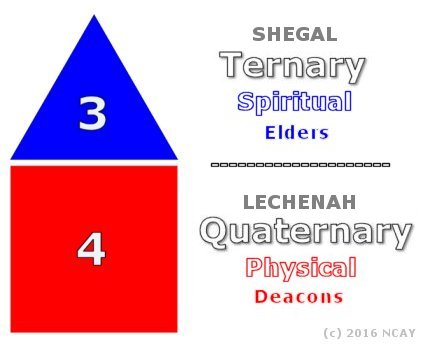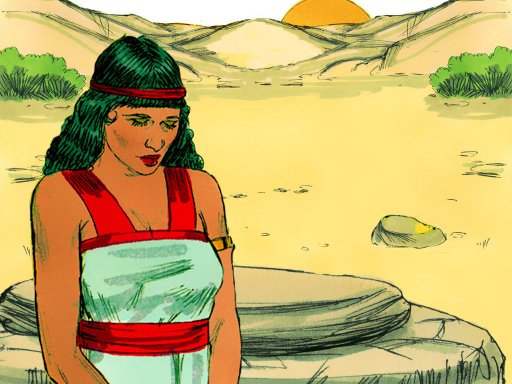Continued from Part 2
The Twelve Books of Abraham, which are used by our Order in defining and regulating echad plural marriage in a practical context, describe the existence of two primary orders of marriage which, when examined closely, very much resemble the distinctions between the two priesthood orders found in the New Testament, namely, the Deaconate (Shamashim/Servants) and Eldership (Zaqenim). These we refer to by their Old Testament designations as, respectively, the Lechenah (Deaconess Wives) and Shegal Orders (Eldress Wives) (see Part 1 of this series). This terminology is used of the Bride of Christ in the Messianic Psalm 45:9 and the distinction between the two (when used of disciples) in John 15:15. Unlike the Old Covenant marriage system which acknowledged full- (ishshah) and half-wives (pilegesh), under the New Covenant no such legal distinction exists. Instead, we are told, that we progress from being the "servants" (cp. Deacons and Lechenah-Wives) of the Messiah to being his "friends" (cp. Elders and Shegal-Wives) as we become truthworthy of such a title and enter into His mystery.
Throughout the Bible you will discover that a great mystery surrounds the number 7 or septenary, a number often referred to as the 'mystery of creation'. Indeed, the number 7 is so firmly planted in our subconscious by Yahweh that if a man is offered a choice between two lottery tickets, one of which is numbered 7 and the other 13, he will almost invariably choose the former, however long he may deliberate over it. There are, of course, those individuals who make a show of their independence in these issues by choosing 13, but such people are acting in a spirit of conscious bravado and that their overt actions have to overcome a great deal of internal resistance. If you ask a dozen people in succession to name any number between 1 and 10 quickly you will discover that in at least 8 out of 12 cases that the response is '7'. Why is it that we do this? Is it mere superstition or does it reflect some unconscious process deeply engrained into our psyche by the Creator, Yahweh-Elohim?
It must at this stage be pointed out that there is no such thing as 'seven' - there can be seven days in a week or seven notes in a diatonic scale. So when we talk about a number like seven we are talking about an idea or a concept, or better still, a form or pattern. The number 7 is, in fact, more than even these, but it a fundamental rhythm. The seventh day is the Sabbath Day, our mandatory day of rest. The phases of the moon change every 7 days, and there is a 7-day period between the spring tide and the neap tide. Yahweh chose the moon, which operates in the 7-day rhythm, as the basis of Israel's calendar, and has never abrogated it. And yet this 7-day cycle must somehow even transcend this lunar clock because we discover that when Yahweh created all things He did so in a 7-day cycle, of which creating the lunar clock was a part. The Lord's Prayer contains - believe it or not - 7 petitions, the first three being Yahweh-directed and the last four man-directed, showing that this number can be broken down into 3 and 4. The Pseudepigraphical Jewish literature describes 7 heavens, the first 3 of which are mentioned by Paul (2 Corinthians 12:2) and which he describes as 3 resurrection glories corresponding in brilliance to the light which we see when we behold sun, moon, and stars (1 Corinthians 15:41). There are 7 eyes of the Elohim (God) which range across the earth (Zechariah 3:9) and we know that the Ruach haQodesh or Holy Spirit consists of 7 persons (Revelation 1:4; 3:1; 4:4; 5:6). Indeed, this number appears 54 times in the Book of Revelation, the 7 churches or assemblies of Asia Minor being chosen to represent symbolically the whole of the Messianic Community and the 7 types of believer in their various stages of sanctification. And finally (for this discussion could occupy a whole book given the opportunity to do so), the whole concept of an oath, covenant or agreement is tied up with the number 7, for 'to swear' in Hebrew is to literally 'come under the influence of 7'.
 Additive colours of the light spectrum
Additive colours of the light spectrum
As you know, the number 7 figures heavily in the mystery of plural marriage or polygamy. We are told that in the last days, when the Israelite theocracy is restored in the millennium after the repentance of the sons and daughters of Israel, that 7 women will take hold of 1 man and beg to receive his name, forfeiting their marital rights if needs be to attain this desired union (Isaiah 4:1), so important to them is this quest for echadness. This sevenfold division which aspires to oneness is to be found in the very nature of light itself which, if passed through a prism, divides into 7 primary colours. And then, when we take a closer look at these primary colours, we discover something quite astonishing about them, namely, that 3 of them are 'pure' colours (red, yellow, blue) and 4 mixtures of colours (orange = red + yellow, green = yellow + blue, violet = blue + red, brown = all the others mixed). Now the seventh colour is not actually a rainbow spectrum at all and yet it is the most common colour on the earth, that of the soil. By interlacing the 3 primary or pure colours we obtain the 3 dual or secondary colours plus the 7th brown which combines all of them.

Once again we are faced with the dichotomy of 3 + 4 which represent the ternary or higher order (3) and the quaternary or lower order (4). Thus with 3 elements (A,B,C) we are able to produce 7 combinations (A, B, C, AB, AC, BC and ABC). But that is not all: if we further mix these 7 elements by deciding that the order in which the elements appear in a mixture is to count, then exactly 12 ways exist of mixing the 3 pure elements, 4 in which A appears first, 4 in which B appears first, and 4 in which C appears first: AB, AC, ABC, ACB; BA, BC, BAC, BCA; CA, CB, CAB, CBA. Hence we arrive at another mystical number in Scripture, namely 12, reminding us at once of the 12 tribes of Israel and the 12 apostles, of which 3 (Peter, James and John) were a presiding Triumvirate, Apostolate or Patriarchate.

There is one last 7-fold symbol which we must briefly mention before we take a further look at the two orders of sister-wives, namely the Hebrew menorah or 7-armed candlearbre whose construction was commanded by Yahweh for use in the Temple and which has become a symbol both of the modern Israeli Republic as well of Messianic Jews. The central arm will be seen to possess 3 nodes (coloured blue in the diagram below) from which the other 3 arms (on the left and right, respectively) emerge. Out of 3 emerge two more 3's (green and red, respectively), giving us an interesting combination of 333. Upon a closer inspection of this number it will be seen that it refers, in fact, to three Hebrew words whose letters combine to give this number, representing shegal ('queen wife', the term used of the Messianic Bride), sheleg ('snow', as in purity), and galash ('to lie down', denoting female position in sexual union - see Echad Sex: Contemplative Intimacy in New Covenant Plural Marriage). This symbol therefore represents (on one level) the mystical union of Yahweh with Israel (or Yah'shua/Jesus with the Church/Messianic Community) and on another, the mystical union of polygamous marriage.

We return briefly to the concept of ternary (3) and quaternary (4) which are the two parts of the septenary (7). The number 3 immediately reminds us of the presiding principle of the Creation, namely the Godhead or Elohim consisting of Father, Son, and Ruach haQodesh (Holy Spirit) (Matthew 28:19), which itself expands into 9 (333) because of the 7-fold nature of the Ruach (Spirit). If the ternary (3) represents the higher aspect of 7, what then does the quaternary (4) represent?
The Book of Revelation alone answers that question for us where we discover that before the throne of the Elohim (God) are 4 living creatures of unusual appearance who are noted especially to be full of eyes (e.g. Revelation 4:6), reminding us immediately of the 7 eyes of Elohim (God) that roam the earth. These creatures are praising Yahweh, using the ternary invocation of praise: "Holy, holy, holy, Yahweh-Elohim Almighty" (Revelation 4:8, NKJV). The number 4 appears as the 4 symbolic corners of the earth - north, south, west and east (Revelation 20:8), the 4 angels of destruction (Revelation 9:15), the 4 horns of the golden altar (Revelation 9:13), and so on, and always in a position subordinate to 3 or 7. We are reminded also of the 4-fold witness of the earthly Evangelists (Matthew, Mark, Luke and John) who penned the Gospels, each with a slightly different witness.

What, then, is the number 4 symbolic of? It is symbolic of the earth, of physicality, of material, or human nature. All matter consists of various combinations of the four elements: earth (solidity, weight and resistance), water (fluidity, conformation, and passivity), air (space, freedom of movement, and expansion), and fire (basic energy, force, and thrust). They are the four points of the compass (N, S, W, E) and our four dimensional world (length, breadth, height and time). Finally, 4 represents the states of human nature or psychological types (i.e. psychic phenomena) which occupy the 4 points of stability and instability, introverted and extroverted, with the psychic space between them:
- (1) Between Instability and Introversion we have moodiness, anxiety, sobriety, rigidity and withdrawness;
- (2) Between Introversion and Stability we have passivity, care, peacefulness, reliability, and calmness;
- (3) Between Stability and Extraversion we have sociability, liveliness, responsiveness, leadership, and carefreeness; and
- (4) Between Extraversion and Instability we have touchiness, excitability, aggressiveness, activity and impulsiveness.
In short, the quaternary represents what may be described as 'earthiness' or the 'physical man' in contradistinction to the spiritual man represented by the ternary (3).
What, or who, then, are the seven women of Isaiah 4:1 who take hold of one man (echad)? Yes, they are literally seven plural wives but they also represent the whole man (7) in relationship to the Creator seeking echad or unity - they are seeking the Name of Yahweh through Christ, to become one with Him. Plural marriage or polygamy, then, is a manifestation of mankind's urge for union with Elohim (God). He wishes to lift himself (at length) above the swirling confusion of psychic energy represented by the four elements - the contradictions of emotions and physical passions which pull him first one way, and then another. He wishes to bring the 4 into union with the 3, and to create 7-in-1, just as the Holy Spirit is 7-in-1. What, then, is the ternary (3) in man actually?
The number 3 is a fixative particularly in the realm of sanctity. "Holy, holy, holy", or the unholy 666, 6 being the number of man elevated to godhood as 666 (the satanic blasphemy). 3 is the number of the forces of Creation deriving from the Godhead of Father, Son and Holy Spirit. It is represented by a pair of opposites (Father and Mother/Holy Spirit) plus an interacting factor (the Son). We see this princple at work in the physical realm in simple mechanics, the forces on a body being represented by a simple vector like a boat in the ocean being moved by the ocean current and the wind in two directions leading to a third. The Son is the vector of the Father and Mother (Spirit), the instrument of creation (Colossians 1:16) - see diagram below. The third principle of creation enables a sort of equilibrium to be maintained in the manifestion of the Elohim (God). I use the word 'sort of' advisedly because complete equilibrium is never attained in the material universe. There is always under- or over-compensation which results in continuous change or flux - a state of becoming rather than a state of being, which is the way the New Covenant is described relative to the Old which has passed away, as also the Priesthood of Yahweh which is always in the making and never complete in this sphere.

False religion removes the original source of this ternary - the Elohim (God) and substitutes mere 'forces'. Idolatry and paganism worship the creation or the creature instead of the Creator. Occultism is essentially a removal of Yahweh and Yah'shua (Jesus) from the creative and redemptive process which leads to a kind of pantheism which is basic to all Hindu, Buddhist and New Age philosophy, which then disconnect the material from the spiritual and then speak only of 'spiritual resurrection'. But the Bible message is that we are to integrate the 3 (spiritual) with the 4 (psychic/material) through the atonement of Christ, uniting the septenary (7) which is man with the Creator, which is Yahweh in Christ. That unification can only take place through the uniting of opposites - male and female, man and woman. The Godhead itself is in this creative marriage union and this principle or pattern is duplicated at every level of the Creation.
The ternary (3) represents the spiritual sister-wife (the queen Shegal Wife) and the quaternary (4) the carnal sister-wife (the servant Lechenah Wife). In mortality there is a war of ascendancy between the two, the carnal lechenah seeking to overpower and rule the spiritual shegal - the husband's servant-concubine trying to usurp the position of the husband's royal friend-queen, a phenomenon we sadly see in the 'pals with Jesus' mentality of many young and immature believers who think that by mere profession of faith they are automatically in the third heaven in the throneroom of Yahweh, daring to occupy the thrones of overcomer-kings. In a word, a kind of spiritual proletariat, communistic rebellion and revolution.
We must all, as disciples of Christ, make the transition from quaternary lechenah wife (4) to ternary shegal wife (3) by making the 4 subject to the 3 so that the 7 comes into proper alignment in the divine hierarchy. We begin our discipleship as allegorical concubines of the Master, as servants (deacons and deaconesses) until we have matured into His friends (elders and eldresses) and, at length, at the last day, when we have overcome, are crowned kings and queens in the Kingdom of the King of kings.
The apostle Paul warns Timothy not to hastily ordain new members to be congregational leaders lest they become proud and conceited (1 Timothy 5:22). For no matter what their giftedness they must still bring the quaternary (4) into subjection to the ternary (3), the carnal into obedience to the spiritual. Similarly, no new wife coming into a polygamous family (or even an old one who has not overcome, for that matter) can expect to suddenly be placed in a position of favour by virtue of marriage alone, but must like all disciples overcome the carnal tendency to dominate and await until she is called by her master, her husband, to occupy the place which the other wives (if they have overcome) through their natural submission. This means that a new wife should be inducted into covenants of total obedience to her husband and subjection to her sister-wives as an apprentice of sorts until she also is called from the Lechenah Order to the Shegal Order. And this she will be once she has brought the outer flesh into subjection of the ruach (spirit).
This was something that Hagar never did accomplish. Though technically a pilegesh concubine under the Old Covenant, she was in her spirit a lechenah bride also, for she would not subject herself to her mistress Sarah except under a dark cloud of resentment and boastful arrogance, which spirit passed to her son Ishmael who attempted to assassinate the Messianic seed, Isaac, and as a result mother and son were forced to remove themselves from the camp of Abraham where they would no longer be a danger. For the spirit of the quaternary (4), if it is not brought into subjection to the ternary (3), rapidly becomes the spirit of murder, which is jealosy (envy), pride, and all that is evil, shattering echad unity. Left to degenerate even further, they will descend into the seven cardinal sins.
 The seven cardinal sins, the sevenfold anti-menorah
The seven cardinal sins, the sevenfold anti-menorah
Every new wife in a plural family, no matter what her age or experience, should therefore be placed in a position of submission not only to her husband but also to the other sister-wives until she has demonstrated through repentance and a true Christian/Messianic walk that she has mastered the carnal sufficiently, revealing the ternary spirit to be in the ascendancy. This the husband, as family pastor, must monitor and judge. Such a position of subservience may exist for a very short or a very long time, depending on the spiritual disposition of the wife and her success or failure to overcome sufficiently.
Whilst this is not a licence for oppression, it does maintain and establish the biblical pattern in all its several Old and New Testament correspondences. The aim is always the quality and unity of echad. However, we must never fall into the trap of believing we can circumvent this spiritual disciplining stage out of a godly heart-felt desire to induct a new wife into the fullness of what is already there. The New Covenant attitude is, of course, to love freely, and without counting the cost. But balanced against this must be certain restrictions that derive from carnal realities - Elders and Eldresses are not made overnight any more than Patriarchs and Shegal wives are. Neither is it necessarily a product of age, but rather of yieldedness and obedience in love and faith. And it follows that if a wife will not yield, or if she brings with her a destructive influence that will not be contained and overcome, that like Hagar she must have a separate home made for her which, as the pseudepigraphical Book of Jasher informs us (Joshua 10:13; 2 Samuel 1:18), Abraham would annually visit. But if she will wrestle and overcome as Leah and Rachel, then she may abide with her sister-wives in grace and peace.
 Hagar was a lechenah wife both spiritually and legally as a concubine
Hagar was a lechenah wife both spiritually and legally as a concubine
To build an echad plural marriage is a great challenge and by no means easy, but one that is truly blessed when those involved have overcome - the husband when he is ruling and loving as a true Patriarch, as Christ rules and loves the Church or Messianic Community -- and the wives when they are in complete subjection to their lord, master and husband in a spirit of quietness and peace, as the redeemed Church or Messianic Community is to Yah'shua (Jesus) her Bridegroom.
We have seen that there are two levels that correspond to the spiritual ternary (3), the Eldress and the Shegal Wife, and the carnal quaternary (4), the Deaconess, and the Lechenah or New Covenant Concubine ... not a half-wife but a full or Shegal wife-in-the-making. When such a structure is in place, peace, order and love will reign in the Christian/Messianic polygamous home. Where it is not, there is but strife, trouble and - if nothing is done about it - ultimate dissolution.
 The success or failure of polygamy is the choice to overcome or not
The success or failure of polygamy is the choice to overcome or not
May Yahweh our Father lead and guide you in these things in His peace and love.
Author: SBSK















































